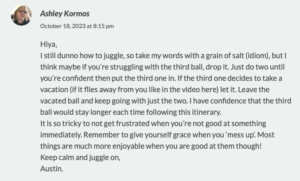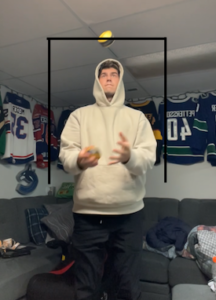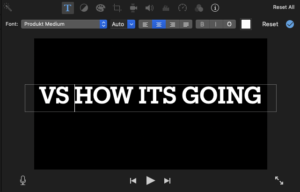Learning to juggle offered me various valuable benefits. Before engaging in this activity, one of the things I wanted to focus on was my hand-eye coordination, juggling challenges you to precisely track moving objects and synchronize your hands’ movements. The process of juggling encourages the development of ambidexterity, as both hands are utilized. Beyond the physical aspects, the cognitive benefits are evident as you have to focus on timing and attention. It contributes to the refinement of my motor skills, both fine and gross.
- Improve hand eye coordination
- Development of ambidexterity
- Focus, attention, and timing
- Persistence and patience
- Intrinsically rewarding
- Challenging to learn
As I experimented with various juggling patterns, I find joy and entertainment in this skill, making the learning journey both valuable and enjoyable for me.
While I still have trouble juggling for an extended amount of time, I am proud of how far I have come. Can my girlfriend still juggle better than me? Certainly. Do I still get frustrated when practicing? Absolutely I do. But I have shown glimpses of good habits along the way.
Full Recap
- Reasons to want to learn to juggle
- Resources I think I can use include
- Focuses to start out
- Progressions
- Other reasons I want to learn
- Wikihow to start the basics
First take on juggling, jumped right into it after not trying for a long time.
Youtube lady named Taylor Tries really helped jumpstart the juggling process.
Valuable lessons
- All about messing up and getting better in little increments
- Dont get frustrated
- Enjoy the journey
- Bean bags are the best way to go
Tried out Imovie and had some success making a video
In terms of use in the classroom, iMovie can be a great tool for:
- Digital Storytelling
- Virtual Field Trips
- Interviews
- Peer Reviews
- Digital Portfolios
- Collaborative Projects
Went into the SAMR Model
Substitution:
At the Substitution level, iMovie could be used as a basic video playback tool. Teachers and students use it to watch educational videos or films
Augmentation:
At the Augmentation level, iMovie starts to enhance the learning experience. Teachers and students use basic editing features to trim or add text to videos.
Modification:
The Modification level involves more significant changes to the learning experience. In this case, iMovie is used to create multimedia presentations or reports.
Redefinition:
At the Redefinition level, iMovie is used to transform the way students learn and demonstrate their understanding. It enables tasks that were not possible without technology.
I had a reply on a posts of mine about going down to 2 balls instead of 3, this ended up helping immensely and was a big focus of mine.

- I went down to 2 balls and practiced consistency, it was a Taylor Treis tip
- Practice “throw, throw, catch, catch” pattern down.
- Started to get a rhythm
- My girlfriend had a great tip for me, I was to practice against a wall so that I am forced to throw the ball in an area where I am going to catch it, without it hitting the wall.
Good to take ideas from other people and use your resources.

Positive reinforcement from classmates really helped along the way.
Realizing that with lots of practice, juggling is not impossible
Found a professional juggler on youtube and I watched him religiously
Started to explore Tik Tok and fell in love with the video creating process
Wanted to incorporate juggling into my routine before hockey practice as a way to warm up

Two birds is right!
Main ideas from the professional
- Peripherals
- Consistent throws
- Make eye contact with the ball at its highest point
- Give your hands information about it where it will land
- Move around to increase difficulty
The sand filled balls are way better to juggle with than anything that I tried
Really gaining traction with going back to 3 ball juggling
My youtube instructor has helped me so much in my juggling journey, 3:35 of this video will gave me many tips.
For anyone interested in juggling, the wall tip is extremely useful.
Tik Tok also made the content process a breeze, editing and audio options are great.
At this point, still struggling getting the 3rd ball in the air and caught properly. Rhythm is right there.
Back to my youtube coach, he does a great job explaining what the benefits are for practicing juggling with 1 hand.
Benefits
- Precise hand-eye coordination
- Using both your dominant and non-dominant hand
- Extra level of challenge
- Motor coordination and dexterity.
- Persistence
I found success with throwing the balls high, tried to incorporate the height aspect to the 3 ball juggling
Counting out which ball is being thrown was tricky to start but once I got the hang of it, became smooth.
Some of the key things I focused on
- Not getting frustrated
- Throw the balls closer to my body
- Find a good rhythm
- Get all the balls to the same height
- Focus on each ball at the top
6:11 of the Jack Kalvan video does a great explanation.
Walking backward while juggling can do many things:
- Improves coordination
- Fine-tunes motor skills
- Enhances multitasking abilities
- Forces you to throw the ball in the air more towards your body
(Way harder than it looks)
He makes it look easy
Final Thoughts








Recent Comments